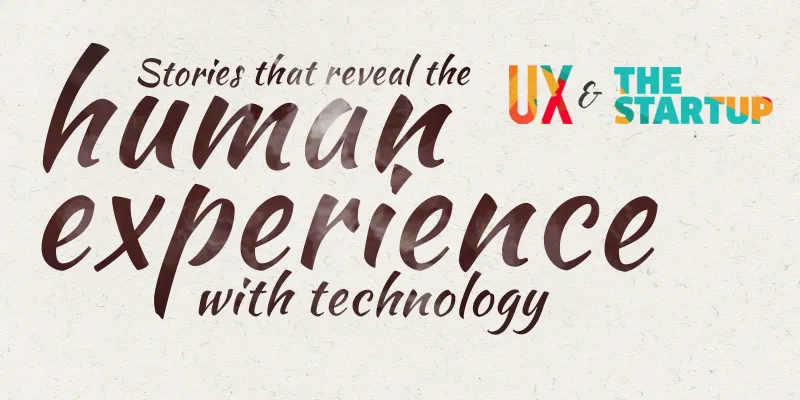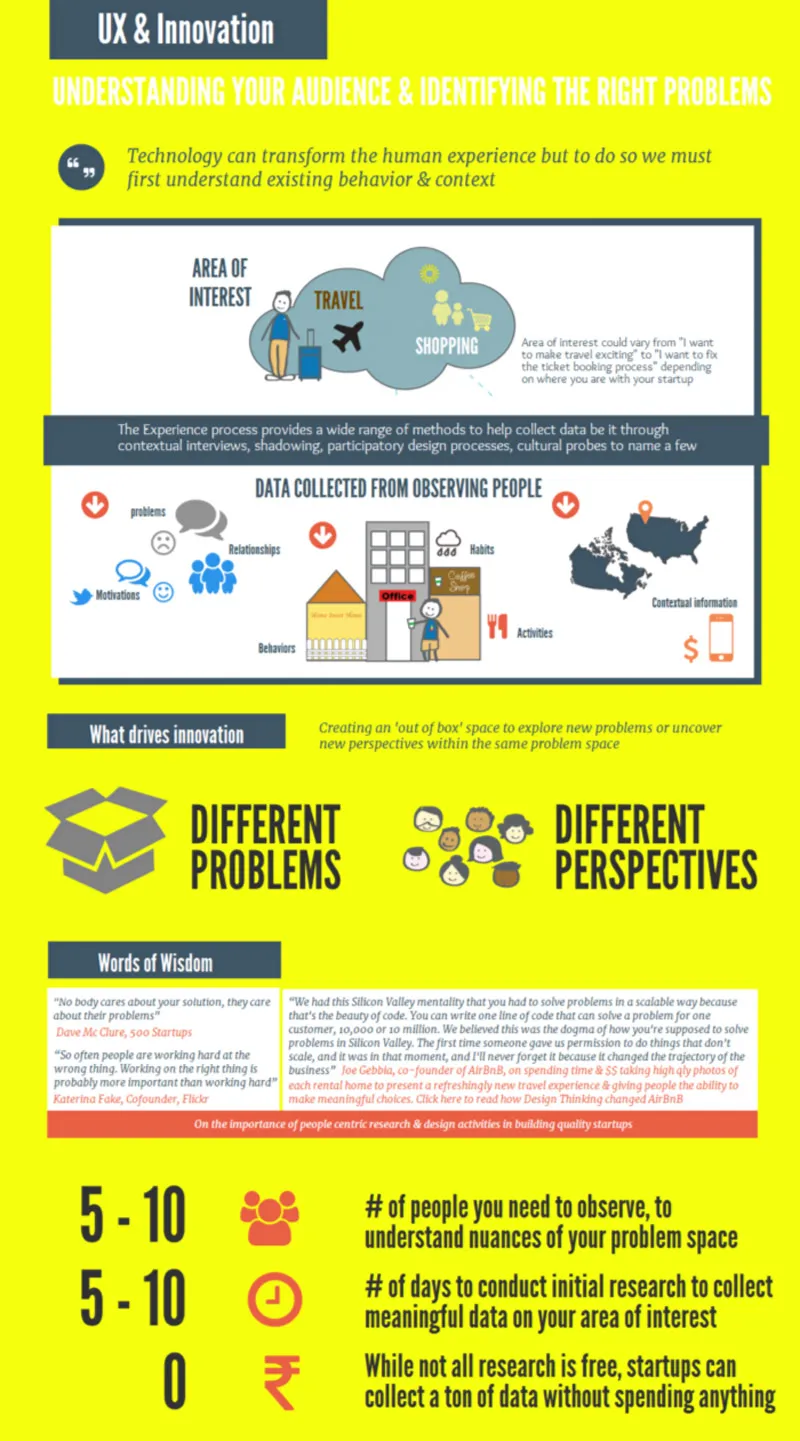Why Indian startups need Experience Design now more than ever before

It’s been raining startups here in India! Big news, big exits, lots of action lately. And two specific topics have been particularly louder than others. One, our tech community has been heavily musing how we put our people and skills on the global platform. And two, there’s been a lot of discussion around bringing more product focus to our ecosystem. I imagine its highly unlikely that most of us are turning to UX to find answers for these questions. But these are precisely the kind of questions that Experience Design as a practice can offer insights into. Before we jump into topics on Design practices, ROI and experience stories from our startups in this column, I thought briefly exploring the question of relevance of UX to this community would help ground us all in the conversations we could have here over the coming months.
The Definition
Let’s start by getting the definition out of the way. There are tons of definitions of UX and models out there, but let’s keep this simple and in plain English. Experience Design is the process of designing products & services that mindfully influence (or cause) people to have different kinds of experiences. And it could be said that the human experience and interaction with those products comprise of 4 parts: usefulness (value I see), usability (ease of use), emotional appeal (how does it make me feel) and aspects leading to behavioral change (expectations the product & behavior change creates of other aspects of life). [1]
Simply put, Experience Design is concerned with the process of understanding experiences people have, their life, the contexts surrounding it & designing for it.
How can UX help?
Putting a community on the global map for their cutting edge innovation is no easy task and certainly requires much much more than Experience Design. That said, Innovation is increasingly turning into this unicorn — this search for the next big thing or the ultimate killer app. How can we mass manufacture a culture of innovation when innovation seems more like a catch-all term than a science that can be carefully crafted into a control experiment? How can we pivot an entire country and it’s youth from continuing to follow an engineering driven ‘outsourcing’ services culture? And of course, pivot and go where? How can we design for needs and contexts unique to our people while still managing to scale globally?
While Experience Design alone cannot provide all these answers, it can help provide us with three very useful components:
- Understanding the audience & identifying the problem — it can help us ask the right questions, identify relevant experiences people have within the space being observed, the problems they face, the values and beliefs that drive certain behaviors;
- Defining the Design strategy — it can provide useful tools to frame the problem, get creative and then define a strategy (aka big picture) to design focused solutions;
- Designing and developing elegant solutions — it gives us a solid set of methods to develop and deliver the vision in an elegant, useful and simple solution.
Each of these 3 components sets us up to drive the development of innovative products & services. They help us go from the ‘me-too’ business building approach to developing groundbreaking businesses that leave a longstanding impact on the human experience. This is the first article in the 3 piece series on the role of UX in innovation exploring briefly the impact of up front user research on your startup.
It’s about time we debunk this myth that user research is something that requires heavy investment of time and money. If planned right with the right tools, approach and questions you could answer all your questions in 5 — 7 days. Myth #2 user research = prototype testing.
When you’ve done your due research before building your MVP to understand your audience, the time, money & resources required to spend iterating and testing reduces heavily.
Ethnography, design research, market research, participatory design all provide a wide range of tools to gather this data about people and the systems within which they function. It helps you identify problem spaces and drill down to specific pain points rapidly, evaluating your hypothesis if you already have one. On the other hand, if you’re just interested in doing something in an area of interest and are not sure of which problem to solve for yet, say travel, UX provides the right tools to help you identify key problem spaces requiring solutions. While asking the right questions and picking the right tools can make or break the path you take, in general, the research can be designed to be simple with basic common sense questions. Pick an area of interest, observe people in relevant contexts, ask them questions, map out user behavior, habits, values, preferences and pain points and consciously stay away from biasing data by adding your own spin to the stories heard rather than being true to what you hear (which is the hardest part of the process). You not only walk away with knowing your audience and their life but the systems within which they function which heavily influence how you approach solutions to the problems identified.
Take the example of AirBnB. It’s a very interesting example depicting how 2 guys decided to solve the problem within travel in a beautifully novel manner by staying true to the observed human condition at the time. Instead of developing another search solution for the hotel industry, the founders focused on 3 key aspects of their users at that time — the fact that travelers were much more price conscious and careful about their travel plans given the recession, two — that hotel prices in cities where conferences were held were being driven up by demand making it unaffordable for youngsters to participate in the gatherings and finally — that the current staying experience removes people from each other rather than connect them to the local setting and to each other. Focusing in on data points specific to their observed setting allowed them to enable people to use existing shared resources and to come up with a unique way to solve the problem that has disrupted an entire travel industry by creating the sharing economy.
If you haven’t seen it yet — take a look at Brian Chesky, AirBnB founder’s interview on Stephen Colbert below and read the story of design thinking at AirBnB.
Brian Chesky’s interview on Stephen Colbert
Joe Gebbia’s interview on AirBnB & Design thinking
Where’s the innovation: This process gives you the ‘out of box’ space to identify interesting problems not typically explored by everyone. What are the odds that you end up with a solution as revolutionary as the sharing economy if you’ve not observed the problems in the current forms of travel and the contexts surrounding them. Pretty low I’d say, especially considering the fears surrounding shacking up with random people. In taking such an intelligence gathering process, not only do you get plenty of data to understand the problem, the existing behavior & experience, it typically gives you plenty of clues about the desired end state or experience. This particularly comes in handy when you’re designing for a specific market or a local audience. A well planned set of research questions can help carve out the local need distinctly making it stand out from generic notions about what people want, further guiding the choice of features and the approach to implementing them.
The Advantage: You don’t fall into the trap of trying to solve the same problems being solved by the industry or going after the same solutions for problems already identified by industry. You also find the difference between implementing for the local environment and need identifying changes in approaches as you scale across geographies.
You’re not just making a better search engine anymore, you’re creating an entire new economy suddenly! You get a different perspective, ‘the out of the box space’.
The Challenges: Gebbia, the designer cofounder, points out in the article below how the startup work process almost never makes space for methods that don’t scale. (Refer infographic and link above for more). And the social sciences concerned with the human experience typically provide modes of inquiry that don’t scale but where the nuggets of change truly lie.
Drop the code once in a while, grab a camera and find the answers you need outside your office, not inside.
And like all processes, another challenge is knowing when you’re not just another wannabe photographer running around headlessly consumed by your own fancy with taking pictures. It’s important to identify the right target group, ask the right questions, employ the right framework and tools to get at the answers you need. Lastly, not everyone wants to design for disruption, consciously acknowledging one path over the other and employing approaches that take you down one can be overwhelming at times but the returns on planning this ahead of development can truly help create waves.
At the end it really all comes down to common sense — how does one define ‘what if’ or ‘what wows’ [2] without understanding ‘what is’?! Ask yourself that the next time you decide to skip studying your people up front in your process.
This is the first part of the 3 part article on the role of UX in innovation. Chime in with your thoughts. Have you found a difference in employing research up front in your process? Has it significantly changed your path? Tell us your story and help us write about your example in the coming weeks.

[1] Mike Kuniavsky
[2] Designing for growth: Jeanne Liedtka & Tim Ogilvie







